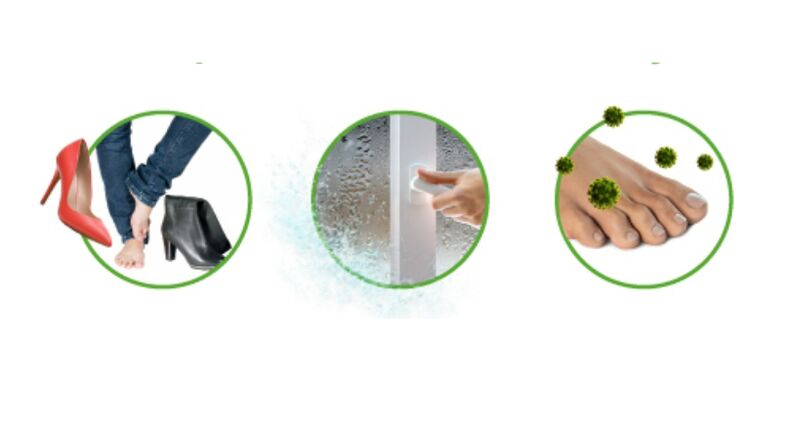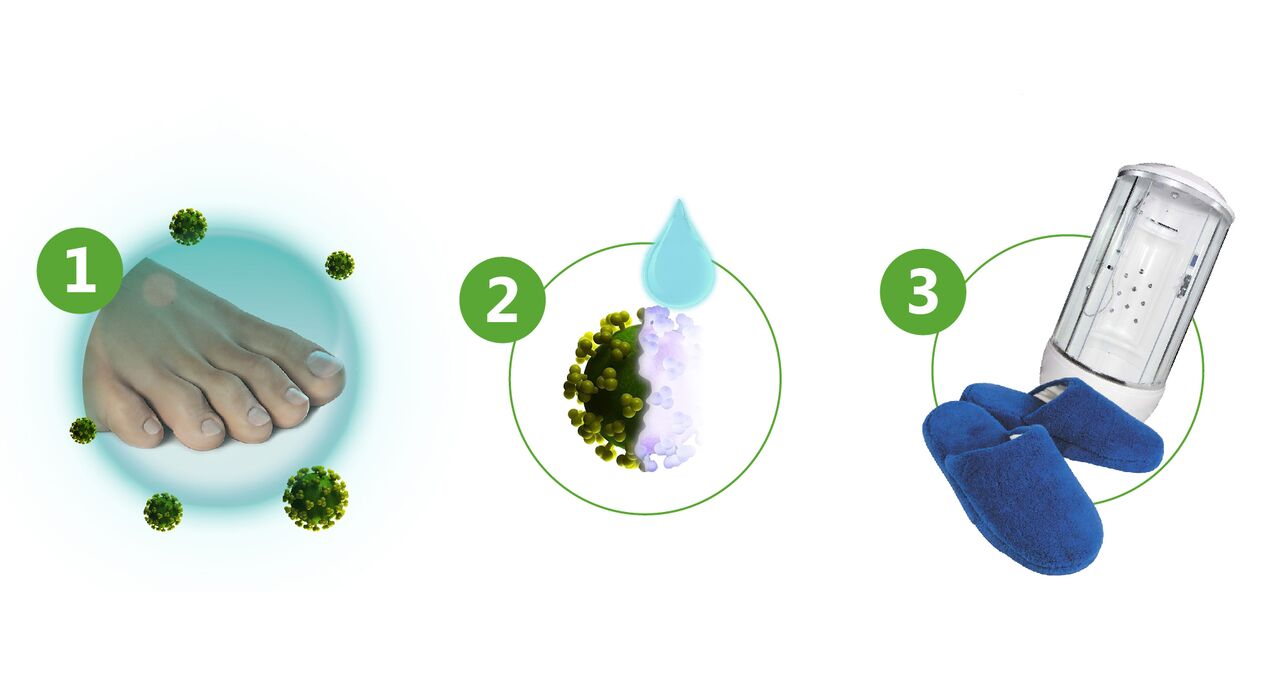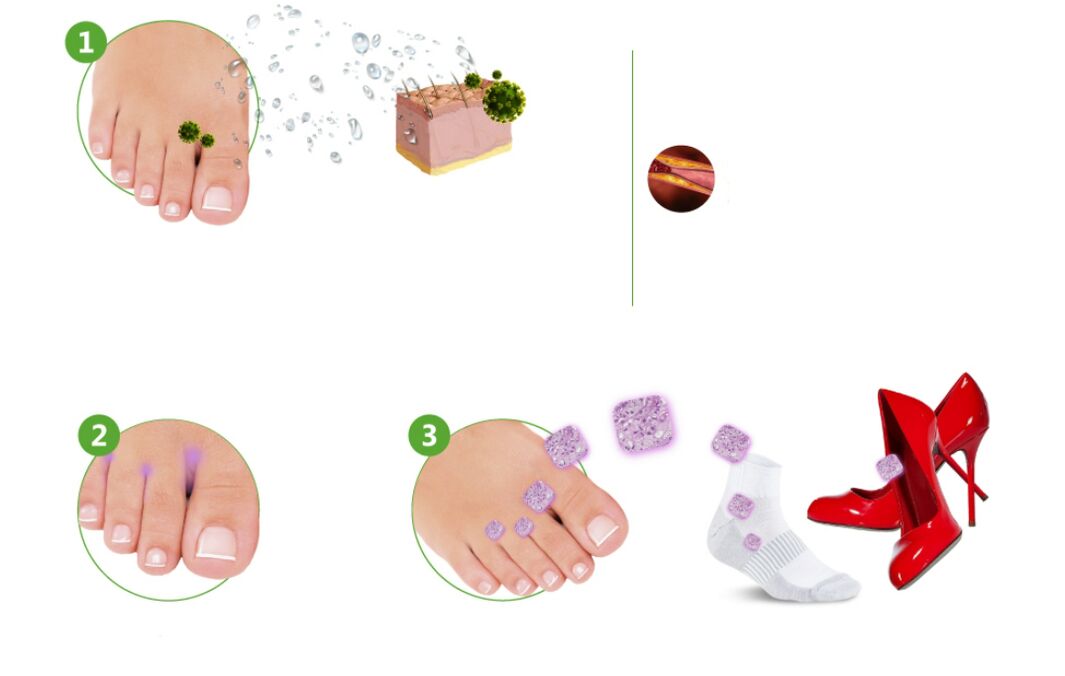One of the most common skin diseases is foot. It occurs in people of all ages and professions. The most common mycoses are found in hot workshops, miners, athletes, and bath workers, with a frequency of more than 60%. Children rarely suffer, but there is already an increase in cases of mycosis in adolescents.
What is foot mycosis
Mycosis of the foot is a group of fungal skin diseases, often accompanied by simultaneous damage to the nails. These infections cause similar clinical manifestations. They can be distinguished only after microscopic examination of the skin and nails. Mycosis of the skin of the feet is a very contagious disease. It is transmitted from person to person through household items: rugs in dressing rooms, showers and pools, benches for feet, pools and floors in baths and saunas. It is dangerous to use common shoes and socks. In the constantly erosive surface layer of the skin there are many fungi themselves and their spores. Initially, the interdigital folds are affected, and itching of the skin occurs. In the future, the infection spreads to the entire foot and spreads to the nails. The course of the disease is long and requires constant treatment. You can get an effective prophylaxis to prevent foot mycosis.

Causes of foot mycosis
The cause of the disease are microorganisms of the genus Trichophyton, less often mold fungi and Epidermophyton floccosum:

- red trichophyton (Tr. Rubrum) causes up to 95% of all cases of the disease;
- about one-third of patients also found interdigital trichophyton (Tr. Interdigitale);
- inguinal epidermophyton (E. floccosum) is the cause of the disease in 1% of cases.
Under unfavorable external conditions, the probability of infection increases:
- high humidity;
- tight shoes;
- frequent visits to swimming pools, saunas and other wet areas;
- having a sick person in the family.
Some internal diseases also contribute to the development of fungal infections:
- sweating of the feet;
- immune deficiency;
- intake of corticosteroid hormones;
- straight legs;
- Raynaud's disease, atherosclerosis of peripheral arteries, obliterating endarteritis, varicose veins;
- diabetes.

What happened during the illness
Mycosis of the feet rarely develops on healthy skin. Even if the fungus comes to the surface, it will not be able to penetrate the thick layer of the entire epithelium. Under the influence of adverse external factors, the epidermis accumulates moisture and empties. Fungi penetrate the thickness of the skin and begin to multiply actively. It is further developed by vascular diseases and immune disorders accompanied by malnutrition and local defense mechanisms in the legs. The proliferation of fungi damages the interdigital areas, causing intense peeling and discomfort. Rejected epithelium enters socks and shoes and becomes a source of re-infection. Therefore, in the treatment of mycosis, the inner surface of the shoe should be treated with a special antifungal agent.

Symptoms
Conventionally, there are the following forms of foot mycosis shown in the photo:
- Squamous: unilateral peeling and slight itching in the arch of the foot. This form is often unrecognized.
- Intertriginous: the folds between the toes are affected, then the process goes to the back of the foot. Crying cracks appear, accompanied by itching. Bacterial infection may be associated with the development of erysipelas.
- Dyshidrotic: Vesicles in the arch of the foot merge with each other with light, then with cloudy content. They open with the formation of painful erosions. This type is accompanied by itching and pain.
In the acute period, mycosis of the skin of the foot may be accompanied by fever, poor health, headache, enlarged inguinal lymph nodes. When infected with Trichophyton, the nail of the I or V finger is affected, and in the future the process spreads to all nail plates. At first, yellow spots appear on the free edge of the nail, then thicken, loosen and break. Therefore, you should use complex action products, such as skin and nail lotions, to treat toenail fungus.

Diagnosis of the disease
Recognition of the disease is based on the analysis of external manifestations and the isolation of the fungus from the skin surface. Microscopic examination of the affected epithelium and nails is performed. They are grown in a nutrient medium to accurately identify the type of microorganisms. Mycosis of the foot should be distinguished from a non-fungal lesion:
- intertrigo;
- eczema;
- psoriasis;
- hyperkeratosis.
Accurate diagnosis ensures good treatment results.
Treatment of foot mycosis
Therapy is carried out in 2 stages. First, it is necessary to eliminate the acute inflammation and remove the horny coverings on the legs. Hot foot baths with potassium permanganate and lotions with a solution of boric acid are indicated. After removal of the dense epithelium, creams containing anti-inflammatory hormones and antibiotics are used. After the inflammation subsides, these creams are replaced with similar ointments. In the second stage of treatment, antifungal ointments and creams are used (for example, representatives of the group of antifungal drugs imidazole). It should be applied to clean, dry skin by gently rubbing 1-2 times a day. Not only the affected area but also the surrounding surface of the foot is treated. The course of treatment takes about a month. Mycosis of the foot is successfully treated with drugs, special lotions for the skin and nails that can be purchased at the pharmacy. Benefits of antifungal drugs:
- high activity against fungi that cause mycosis of the feet;
- security;
- hypoallergenicity;
- reasonable price.
The lotion can be used to treat other skin diseases:
- pityriasis versicolor;
- skin candidiasis;
- erythrasma;
- secondary bacterial infection on the background of mycosis.
The drug is used twice a day, gently rubbed into the affected areas. The skin should first be washed with soap and dried thoroughly, especially between the fingers. The course of treatment lasts until the symptoms of the disease disappear and for another 2 weeks. The drug is well tolerated. Only occasionally causes skin irritation. It has the only contraindication - in the first trimester of pregnancy. Of course, clotrimazole is not used for individual intolerance. One of the advantages of the lotion is that the drug penetrates perfectly into the nail plates, which distinguishes it from creams or ointments. Regular use of this drug gives excellent results in the mycosis of the feet and nails without the use of additional means. Damage to the nails requires the appointment of antifungal drugs inside.
At the same time, therapeutic varnishes are applied to the nails 1-2 times a week until complete recovery.
Preventive methods
Treatment of fungal infections is long. Mycosis of the feet requires the use of very expensive drugs. Prevention is especially important in people with risk factors for the disease. Athletes, swimmers, and hot shop workers are advised to use antifungal and antibacterial medications, such as sprays or lotions, on a regular basis. Such products are safe, do not damage the skin and do not cause irritation. With regular use, the chances of catching a foot fungus are drastically reduced. Undecylenic acid spray is useful to prevent re-infection. To do this, the drug should be sprayed on the inner surface of the shoe every month. The active ingredient of the spray - undecylenic acid - is so safe with long-term use. It should be applied to the dry, clean skin of the feet before each trip to the pool and other similar places. There are no contraindications to the use of this drug. It should be used with caution only by pregnant and lactating women. External causes of the onset of the disease should be eliminated:
- wear appropriate boots and shoes;
- use high-quality sports shoes made of natural materials;
- wash your feet daily and treat your nails on time;
- combating sweating feet;
- It is better to use light silicone or rubber slippers when visiting the bath, pool, beach.
General strengthening of immunity, treatment of diabetes mellitus and vascular diseases are needed.
























